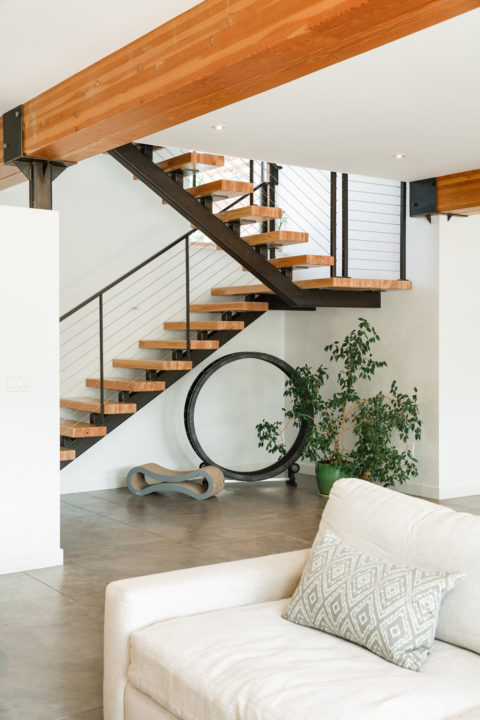The Local newsletter is your free, daily guide to life in Colorado. For locals, by locals. Sign up today!
Green homes sometimes get a bum rap when it comes to aesthetics: They’re all substance and no style, critics say. And then a sustainable design like this sleek, central-Boulder home comes along and invites those naysayers to reconsider. It’s so efficient that it generates enough energy to power an electric car for 10,000 miles a year. But when you walk through the three-bedroom, 2,400-square-foot space, drawn and built by architecture firm Fuentes Design, the green-ness isn’t what you notice first. All that smart functionality is hidden behind thoughtful, high-end minimalist finishes—that shine brightest in a roomy kitchen with a teal back-painted glass backsplash and sleek black cabinets. That style-forward approach, says firm principal Brian Fuentes, is by design: “What I see in modernism and green building is a parallel: that simplicity is beauty.”
So what exactly goes into such an environmentally tuned-in and architecturally dialed-in building? The project began with a vision dreamed up by homeowners Adrian Harris and Madeleine Fairchild, who’d been living in a dated 1950s house on the same lot for years: It was time to upgrade to a low-maintenance space more suited to a lifestyle that’s less about stuff and more about living easily and smartly.
Fuentes had the existing home “deconstructed,” leaving two walls standing (and recycling many of the original building materials). He started over with an open floor plan based on the German engineering philosophy called Passive House (in German, Passivhaus), which uses concepts like an airtight, über-insulated envelope; strategic solar orientation; innovative ventilation; and heating derived from internal sources, such as appliances and human activity. In other words, it’s about creating the most efficient, durable, weatherproof shell possible to minimize the energy it takes to stay comfortable. Think of it this way, Fuentes says: “If you have a puffy jacket on and it gets a hole in it while you’re skiing, you know it right away.” That, he says, is kind of like living in an old house with poor insulation. “And if you’re out in the winter and you have a really nice technical jacket on, you know that, too.” This house is the new jacket.
The triple-pane windows Fuentes imported from Germany put typical double-pane windows to shame: For every unit of energy they lose, they generate four more. These, combined with a nearly 10-kW solar array and concrete floors that soak up warmth from the sun, make for a home that’s 10 times more efficient than a normal house. Plus, because taped seams make the construction so airtight (yes, like your ski jacket), the house has a ventilation system that circulates fresh air every three hours. “It keeps everything balanced and everyone feeling good,” Fuentes says. “People have so much to worry about in life; your house should just work on its own with no adjustments.” Smart and good-looking? We call that sustainability at its best.
Go Green
Five tips to create an environmentally responsible home.
- Consider low-maintenance finishes, such as easy-to-clean concrete floors and reclaimed-wood siding meant to take on a patina as it ages.
- Choose reusable materials, especially for cosmetic applications. This exterior’s vertical raw-steel wall, meant to visually break up the wood siding, is completely recyclable.
- Adopt a less-is-more lifestyle. An open floorplan (with fewer spaces to squirrel away things) will discourage you from accumulating more stuff.
- Don’t skimp on quality. If you’re re-doing windows and doors to improve insulation, splurge on the best engineering. (Here, Fuentes chose Enersign Plus windows by German manufacturer Pazen.)
- Make the small details count. For example, an on- demand hot-water pump may seem nonessential, but think about the water you waste each morning waiting a few minutes for your shower to warm up.












